In this article, you’ll learn what is Lubrication System? and Types of Lubrication System with PDF download.
What is Lubrication System?
Lubrication is essentially required in motor vehicle maintenance. To supply lubrication oil between the moving parts is simply termed as lubrication. Lubrication of all moving parts (Other than nylon, rubber bushed or pre-lubricated components) is essential to reduce friction and wear and to prevent seizures.
Lubrication must be done correctly and the right type of lubrication should be used. Improper lubrication of the engine will cause serious trouble such as scored cylinders, dirty spark plugs, worn or burned-out bearings, misfiring cylinders, stuck piston rings, engine deposits and sludge and excessive fuel consumption.
Read Also: A Complete List of Car Body Parts [Pitcures & Functions]
Types of Lubrication System
Following are the 6 main types of lubrication system:
- Petroil system
- Splash system
- Pressure system
- Semi-pressure system
- Dry sump system
- Wet sump system
#1 Petroil System
In these types of the lubrication system, it is commonly used in the two-stroke petrol engines such as scooters and motorcycles. It is the simplest form of the lubricating system. For lubrication purpose, it does not have any separate part like an oil pump.
But the lubricating oil is added to the petrol itself during filling in the petrol tank of the vehicle in a specified ratio. When fuel enters the crank chamber during engine operation, oil particles go down into the bearing surfaces and lubricate them. The piston rings, cylinder walls, piston pins, etc. are easily lubricated in the same way.
If the engine is allowed to remain unused for a considerable time, the lubricating oil separates off from petrol and starts to clogging of passages in the carburettor, occurring in engine start problems. Thus is the main disadvantages of this system.
Read Also: Different Types of Transmission System Used In Vehicle
#2 Splash System
In these types of lubrication system, the lubricating oil accumulates in an oil trough or sump. A scoop or dipper is made in the lowest part of the connecting rod. When the engine runs, the dipper dips in the oil once in every revolution of the crankshaft and cause the oil to splash on the cylinder walls.
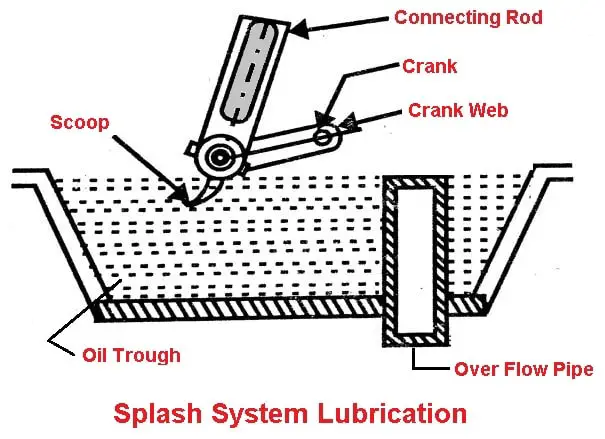
This action affects engine walls, piston rings, crankshaft bearings, and large end bearings. Splash system mostly works in connection with the pressure system in an engine, some parts being lubricated by splash system and the other by a pressure system.
Read Also: Engine: Types of Engines in Automobile with PDF
#3 Pressure System
In these types of lubrication system, engine parts are lubricated under pressure feed. The lubricating oil is stored in a separate tank or the sump, from which an oil pump receives the oil through a strainer and transfers it through a filter to the central oil gallery at a pressure of 2-4 kg/cm2.
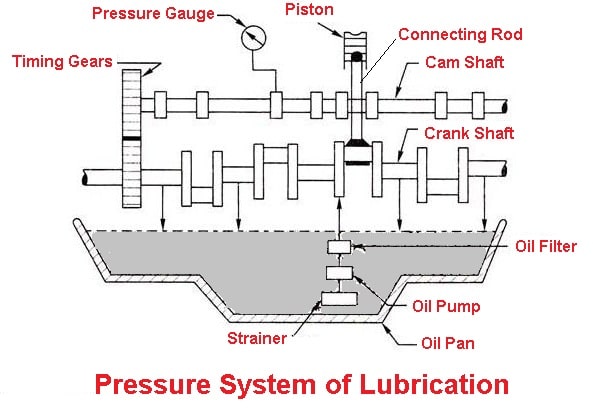
The oil from the main gallery goes to the main bearings, after lubricating the main bearing, some of it goes back to the sump, some is splattered to lubricate the cylinder walls and the rest goes from a hole into the crank pin.
From the crankpin, it goes through a hole in the connecting rod web to the piston pin, where it lubricates the piston rings. To lubricate the timing gears and camshaft, the oil is led through a separate oil line from the oil gallery.
The valve tape is lubricated by attaching the main oil gallery to the tappet guide surfaces through drilled holes. An oil pressure gauge on the instrument panel shows the oil pressure in the system. The oil filters and strainers in the system clear off the oil from dust, metal particles and other dangerous particles.
Read Also: What is the function of a timing belt in a car?
#4 Semi-pressure System
It is the combination of a splash system and pressure system of the lubrication system. Some parts are lubricated by splash system and some parts by a pressure system. Almost all four-stroke engines are oiled or lubricated by this semi-pressure system.
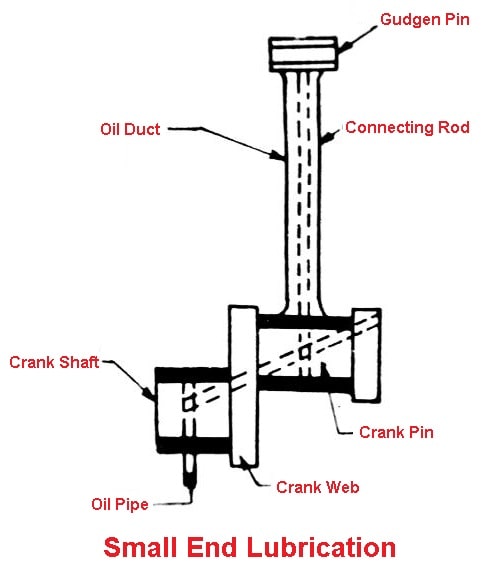
The main supply of oil in this system is located in the base of the crank chamber. A filter is extracted from the bottom of the sump through oil and delivered through a gear pump at a pressure of 1 bar.
Larger bearing ends are lubricated through a nozzle spray. Consequently, the oil also oils or lubricates crankshaft bearings, cams, cylinder walls and timing gears.
The oil supply is measured with the help of oil pressure gauges. This system is less costly to install. This enables high bearing loads and engine speed to be applied than the splash system.
Read Also: List of Car Engine Parts: Its Function
#5 Dry Sump System
The system in which lubricating of oil collects in the oil sump is known as a wet sump system as a pressure system. But the system in which the lubricating oil is not located in the oil sump is known as the dry pump system.
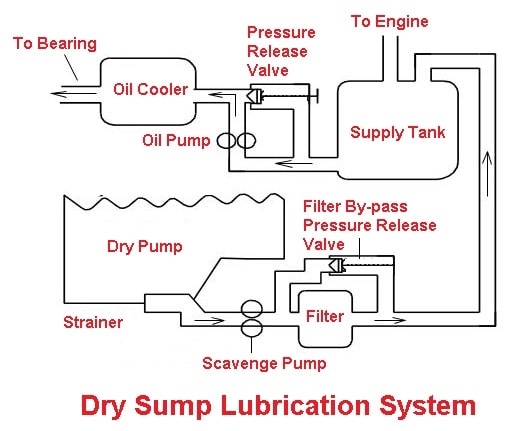
In this system, the vanes sweep the oil from the inlet to the outlet side. As the drum is applied in an eccentric manner, the volume between the drum and the casting continuously decreases and the oil pressure at the outlet increases.
Read Also: Working of Flywheel: Its Advantages & Disadvantages
#6 Wet Sump System
In this system, oil is transported to various engine parts with a sump strainer. In this wet sump system, oil pressure is of about 4 to 5 kg/cm2. After lubrication, the oil is carried back to the oil sump. In this case, the oil is present in the sump. Therefore, it is called a wet sump lubrication system.
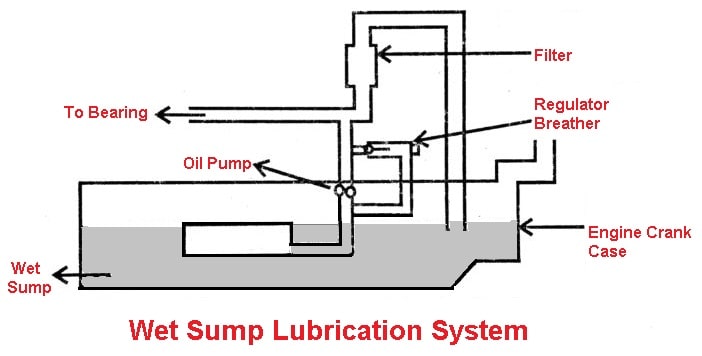
The benefits of a wet sump system are its simplicity. And the oil is close to where it will be applied, doesn’t have a lot of parts to repair, and is relatively safe to build in a car.
Closing It Up
That’s it. Thanks for reading. If you find this article helpful, share this with your friends. Have any questions about the “Types of Lubrication System,” ask in the comments.
Want free PDFs direct to your inbox? Then subscribe to our newsletter.
Download PDF of this article:
Read Next:
- Lubrication System: 8 Different Parts of a Lubrication System [Diagrams & PDF]
- What are the 18 Different Properties of Lubricants [Lubricating Oil]
- Lubrication System in Automobile: Method, Purpose & Application
External Links and References:
- Automatic lubrication system – Wikipedia
- Lubrication Systems – ScienceDirect Topics
- (PDF) LUBRICATION SYSTEM – ResearchGate
Really helpful.
I really need pdf file through my email address.
Thank you.
The PDF file has been sent to your inbox.
Explained well and easy to understand as always.
Please send PDF..Thank you.
Thanks for reading. The PDF file has been sent to your inbox.
Thanks for your concern
You’re welcome.